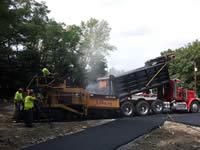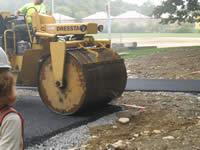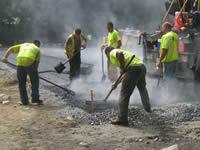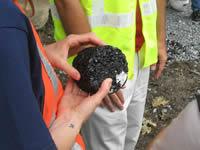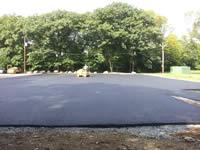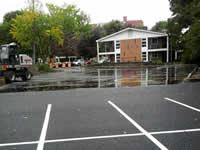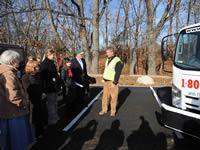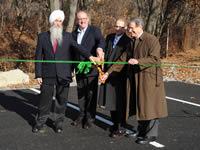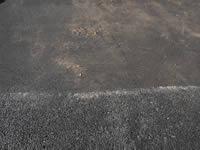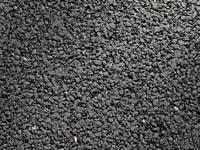Hurd Field Porous Pavement Education Project
- Background/Location
- Benefits of Porous Pavement
- Hurd Field Porous Pavement
- Photo Gallery
- Additional Resources on Porous Pavement
Background/Location
Rainwater and snow melt runs off the surface of traditional pavement and carries pollutants to our water ways. Porous pavement lets water infiltrate into the soil through gaps in all the layers to the groundwater. It also filters pollutants from stormwater and helps protect the water quality of Mill Brook. Since optimum performance of porous pavement depends on these air spaces, sand should not be used in the winter. Porous pavement must be vacuumed (not swept) clean to avoid clogging. Watch the video below to learn more about the porous pavement project on Hurd Field.
Benefits of Porous Pavement
- Reduces the volume and velocity of runoff
- Improves water quality by capturing the water and filtering it
- Replenishes groundwater
- Reduces impacts of flooding during storm events
- Eliminates the need for sanding and reduces the need for road salt in winter months
 View a larger aerial photo of the Hurd Field Parking Lot, Arlington, MA.
View a larger aerial photo of the Hurd Field Parking Lot, Arlington, MA.
Hurd Field Porous Pavement
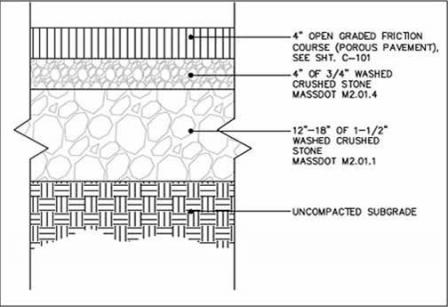 View a larger version of this image.
View a larger version of this image.
See the final draft design of the parking lot.
Photo Gallery
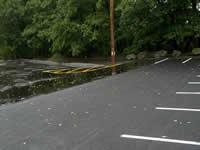 This picture shows the difference between the traditional pavement (on the left) and the porous pavement (on the right).
This picture shows the difference between the traditional pavement (on the left) and the porous pavement (on the right).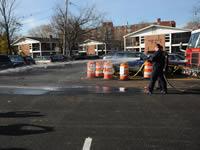 Arlington Fire Department uses a firehose to demonstrate water infiltration through the porous pavement.
Arlington Fire Department uses a firehose to demonstrate water infiltration through the porous pavement. Former EPA Regional Administrator, Curt Spalding, discusses the importance of urban stormwater management and the benefits of porous pavement.
Former EPA Regional Administrator, Curt Spalding, discusses the importance of urban stormwater management and the benefits of porous pavement.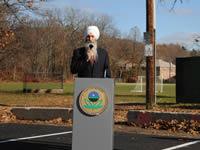 Mystic River Watershed Association Executive Director, EK Khalsa, discusses this project and its benefits to local waterways.
Mystic River Watershed Association Executive Director, EK Khalsa, discusses this project and its benefits to local waterways.Click on thumbnails to view
larger versions of images.
Additional Resources on Porous Pavement
Learn more about Low Impact Development and community projects by checking out EPA's Soak Up the Rain Campaign web site.
University of New Hampshire's Stormwater Center Exit is a resource for information on porous pavement and other low-impact development methods.
Local land use officials addressing the relationship of land use to natural resource protection can learn more about low-impact development for stormwater management through The University of Connecticut's Nonpoint Education for Municipal Officials (NEMO) program. Exit

![Click thumbnail to view a larger version of image. [Before Construction] View of Mill Brook and Hurd Field parking lot looking west](/sites/static/files/styles/large/public/2015-06/hurd-field-b4-constr1-sm.jpg)
![Click thumbnail to view a larger version of image. [Before Construction] View of Hurd Field parking lot looking north west (from Minuteman Bikeway)](/sites/static/files/styles/large/public/2015-06/hurd-field-b4-constr2-sm.jpg)
![Click thumbnail to view a larger version of image. [Before Construction] Path leading to parking lot from Minuteman Bikeway](/sites/static/files/styles/large/public/2015-06/hurd-field-b4-constr3-sm.jpg)
![Click thumbnail to view a larger version of image. [Before Construction] Northern side of parking lot, adjacent to Mill Brook](/sites/static/files/styles/large/public/2015-06/hurd-field-b4-constr4-sm.jpg)
![Click thumbnail to view a larger version of image. [Before Construction] View of parking lot (looking east) with Hurd Field in the background](/sites/static/files/styles/large/public/2015-06/hurd-field-b4-constr5-sm.jpg)
![Click thumbnail to view a larger version of image. [During Construction] Erosion control measures installed around the perimeter of the site.](/sites/static/files/styles/large/public/2015-06/hurd-field-during-constr1-sm.jpg)
![Click thumbnail to view a larger version of image. [During Construction] Existing asphalt being removed from the parking lot.](/sites/static/files/styles/large/public/2015-06/hurd-field-during-constr2-sm.jpg)
![Click thumbnail to view a larger version of image. [During Construction] Existing asphalt being removed and ready to be taken off-site.](/sites/static/files/styles/large/public/2015-06/hurd-field-during-constr3-sm.jpg)
![Click thumbnail to view a larger version of image. [During Construction] Site being graded and new materials being added.](/sites/static/files/styles/large/public/2015-06/hurd-field-during-constr4-sm.jpg)
![Click thumbnail to view a larger version of image. [During Construction] One of the many boulders that was removed from the base-layer.](/sites/static/files/styles/large/public/2015-06/hurd-field-during-constr5-sm.jpg)
![Click thumbnail to view a larger version of image. [During Construction] Construction crew digs one of two infiltration trenches.](/sites/static/files/styles/large/public/2015-06/hurd-field-during-constr6-sm.jpg)
